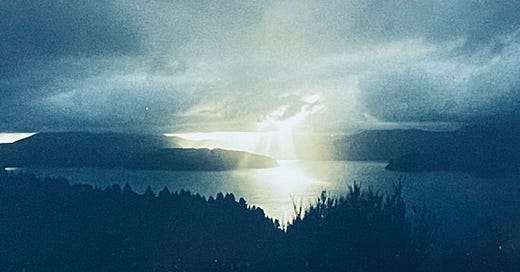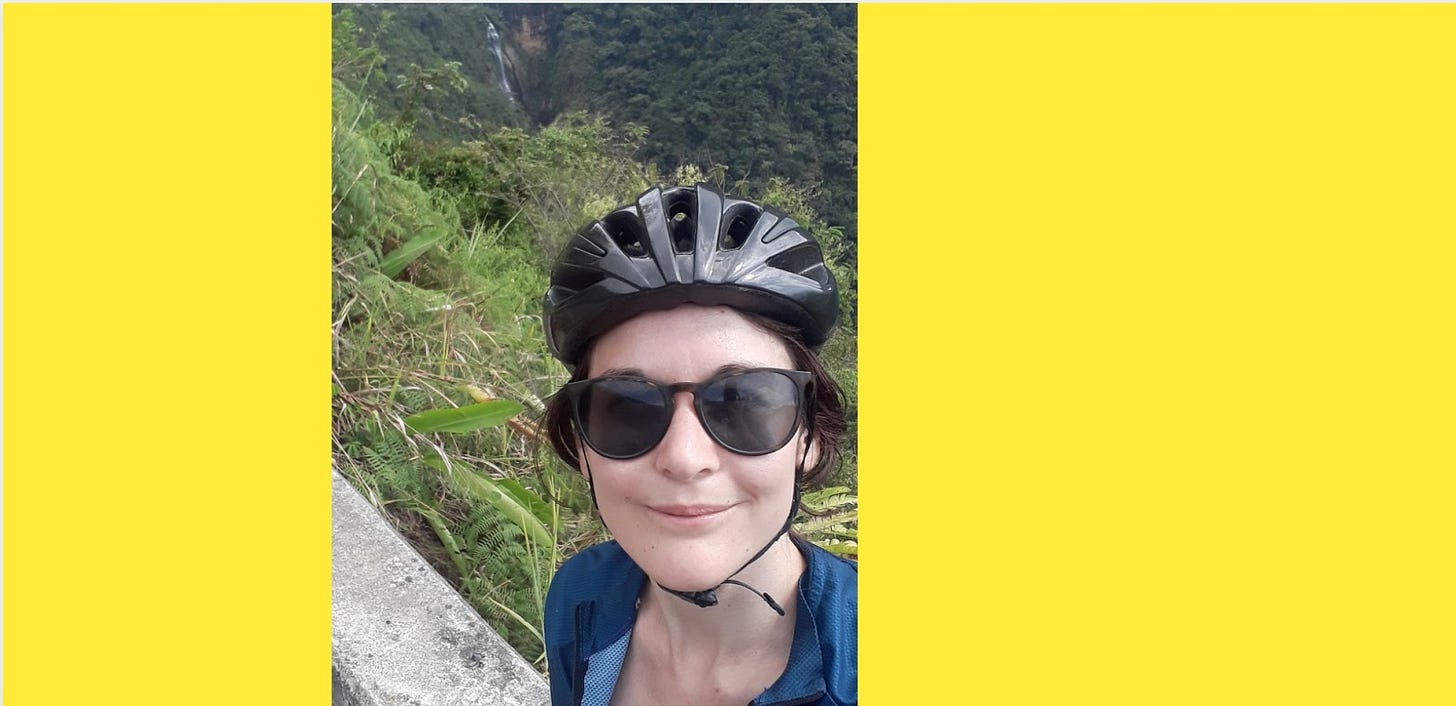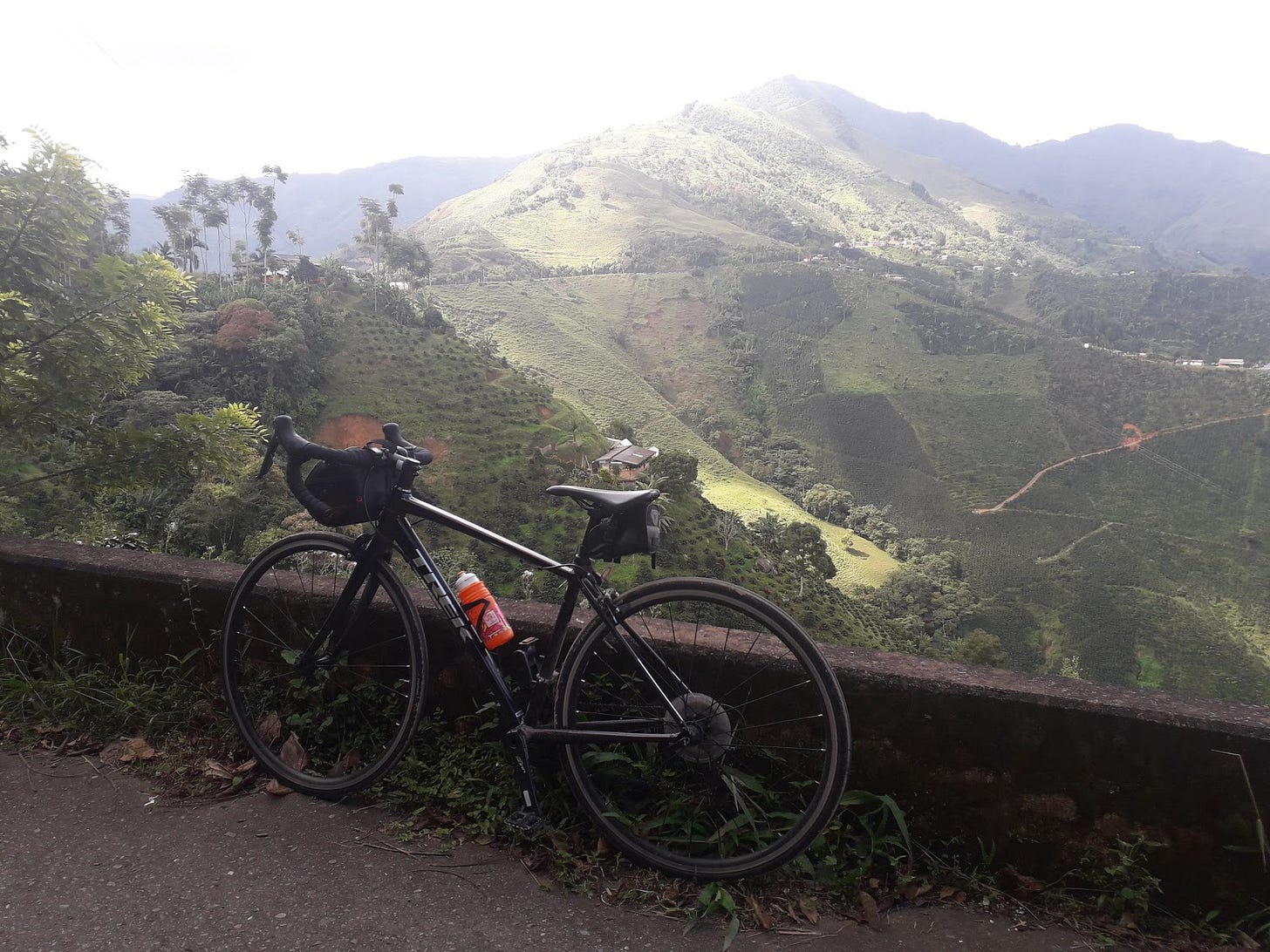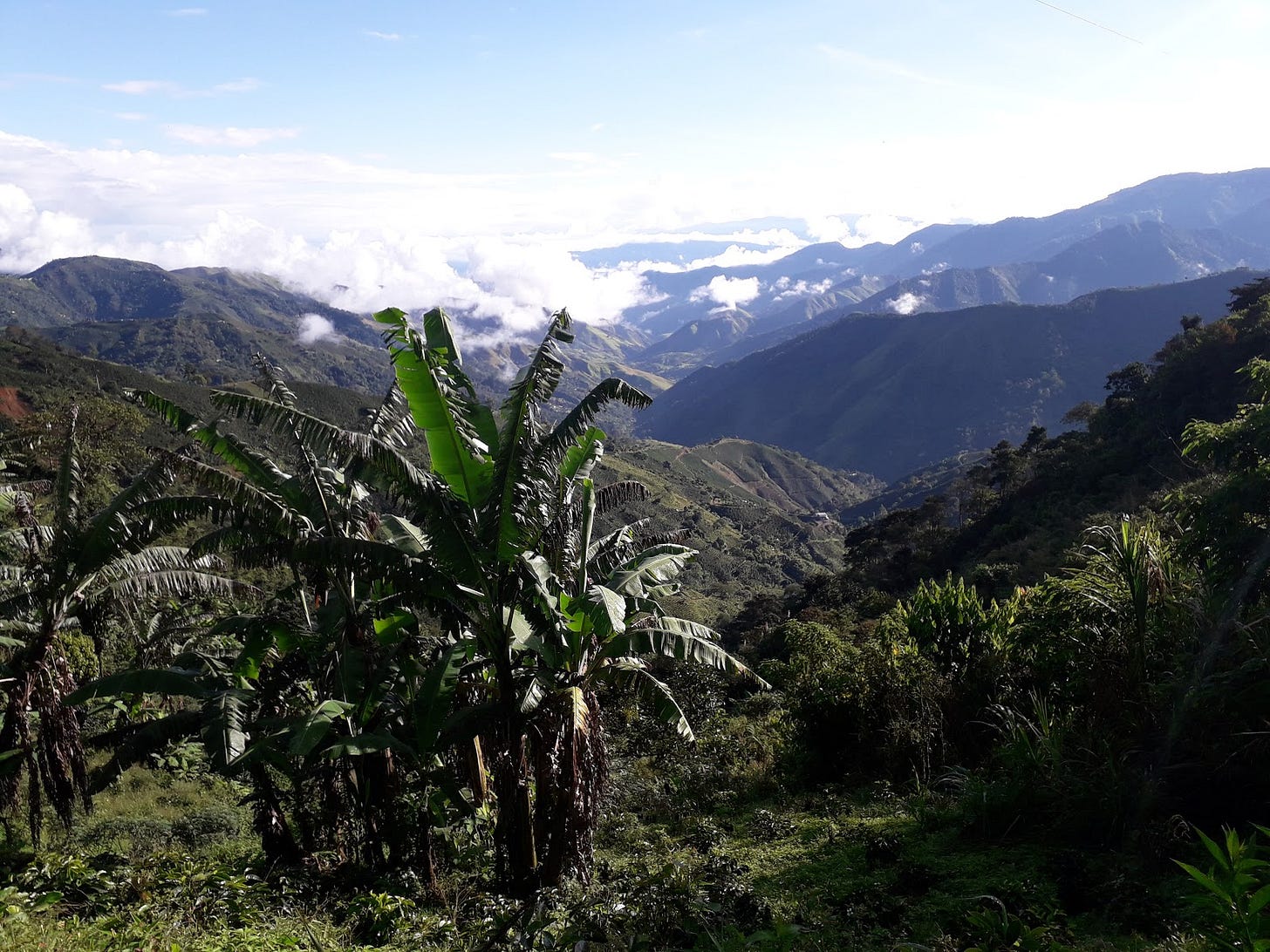Simple climate action // I S S U E # 2 8 // T R A V E L
Turning off the speed alarm
I turned 25 the year of the millennium, and was determined to mark it by doing something special. I bought a plane ticket to New Zealand with vague ideas about getting a job there. But as soon as I arrived, the countryside called me. So I bought a van, and spent six weeks driving round both islands. I had hardly any money and was pretty lonely, but it made for good writing and the country was breathtakingly beautiful.
Twenty years on, it feels a bit of a missed opportunity.
It was liberating to some degree, to have that freedom. But I was also hurtling from one place to another, barely spending more than a few days in any one place, and not really engaging with people I met along the way. Most of the country was a blur streaming past my window. Sometimes I’d hear some rather strange gently tingling bells as I was driving; It took me weeks to work out it was a speed alarm. Or maybe a way of alerting me to everything I was missing by driving past so quickly.
One memory stands out more than any other. It was just past dusk on the South Island, and I’d driven over a mountain pass on a very rough single-track road hacked precipitously into the side of the hill. I pulled over just outside Makarora and made a cup of tea. I remember taking a very deep breath as I looked up, surrounded by the mountains, into a sky filled with more stars than I have ever seen, and a profound, captivating calm and stillness washed over me. I have never had that experience anywhere since. I now wonder if I had rushed less, and been more present, if I had moved through that astonishing country at a more natural pace, if New Zealand wouldn’t have had far more to offer me.
Our story this week is from journalist Kristin Majcher, who now lives in Medellín, Colombia. She explains how bikepacking, setting off on multi-day journeys by bicycle, has revealed to her the delights of slow travel. As the world prepares to pick up the pace once again, her story shows how much adventure awaits in all those miles we might once have rushed past. If you’re inspired to begin your own bikepacking journey, we have the tips to get you started.
Jemima Kiss
In last week’s poll, we asked about your travel plans after the pandemic. It was split: half of you couldn’t wait to leave, and the other half were still “wait and see”—and 3% of you felt they had formed an inseparable bond with their couch 🛋.
Finding adventure, and solace, on two wheels
Adventure doesn’t have to mean traveling far away. The increasingly popular pastime of bikepacking revealed a new appreciation for the landscape around me.
By Kristin Majcher
An epic trip used to mean flying to a foreign country as far away as possible. On vacation, I passed my days sitting on trains, eating in cafés, and staying in places not so different from those I left back at home. Without realizing it, I equated adventure with distance.
But during months of strict Covid-19 lockdown at my home in Bogotá, Colombia, my work shrank. Lockdown meant we couldn’t venture far from home. So a few weeks after restrictions eased in late September, I relocated to Medellín, a mountainous town in the northwest, and started biking to explore.
The reason pro cyclists came to train here became obvious: escaping the city requires a grueling climb to the top of Las Palmas, a busy highway with an anticlimactic strip mall at the top. But reaching the summit unlocked a gorgeous landscape and endless adventures. For the first few weeks, I just had to convince my legs to keep working until reaching the top. Gradually, my trips shifted gears. Hours turned into days. And my definition of epic travel changed along with it.
On my first overnight bike trip, my partner and I pedaled to the Colombian town of Guatapé, a lake district about 85 km from the nearest big city. I’d visited Guatapé once before by bus, but we rediscovered the area again by bike. Not because the roads were different, but because we could stop whenever we wanted to explore along the way. We could feel the changes in altitude as we scaled and descended mountain roads. One morning, after a spontaneous trip up a desolate, unpaved mountain road, we ate lunch on some rocks at the base of a waterfall, and stopped by a lake draped in fog. I lay in the grass watching the lake slowly fade into a milky blue haze, feeling deeply grateful for being able to discover these landscapes with as much time as I needed to appreciate them.
An adventure, not a product
Since the pandemic, travelers like me have questioned the idea that traveling further makes a trip more interesting. Long-distance bike rides—covering a distance that would take just minutes by air—have given me a new sense of epic adventure, and a precious source of solace. A bike has helped me pay attention to so many other things: the way the humidity fades when climbing up a mountain; the brightly-colored snakes sharing the road; the chill that grips the air before a huge thunderstorm. There’s no shortage of challenges and discomfort, including rain, traffic, and flat tires. Yet seeing how far my legs can take me from my front door has given me adventures I’ve never experienced before.
And I am not alone. Bikepacking, the synthesis of biking and minimalist camping, has been gaining popularity even before the pandemic. You strap the essentials to a bike fit for exploring trails and gravel roads away from the main highways. Travel restrictions have fueled a surge of interest, and many people are trying it for the first time. In the US, Outside reports an American “bike boom” could have staying power based on 2020 data about workouts and bike sales. Bike-touring companies see more people staying interested in cycling vacations well after the pandemic passes.
“There is this desire to escape,” says Scott Pankratz, executive director of the Montana-based nonprofit the Adventure Cycling Association. “The pandemic has totally multiplied and magnified [that] because we’re all stuck in our houses. People want to get out, they want to ride bikes, so bikes are hard to find right now…Interest and sales have surged.”
In 2012, Pete McNeil and his wife Alice set off on a bikepacking trip from the UK to New Zealand, and it ended up lasting two years. The couple co-founded UK-based Adventure Pedlars after biking through 22 different countries, hoping to make long-distance cycling accessible to people who had never tried it before. By lending out all the necessary equipment, first-time riders show up with just clothes and a sleeping bag, and don’t have to worry about buying a whole bunch of new gear.
Adventure Pedlars’ trips in the Peak District National Park in the north of England include self-guided bikepacking tours for small groups, guided tours and some glamping options. Through instructional workshops, campers learn how to pack their bikes, perform maintenance, ride off-road, cook over a campfire and navigate. “Ultimately what I want is for them to go off and have their own adventures,” says McNeil. Bikepacking is the ability to travel slowly, stopping in small towns and chatting with people along the way. He tries to give his customers direction and guidance without losing that freedom. After all, one of the parts of a true adventure is going with the flow and being ready for the unknown — something you lose if you plan too much. “As soon as you make it a product, in some ways it ceases to be an adventure,” McNeil says.
Finding my way on two wheels
Marley Blonsky, a Seattle-based bike adventurer, stresses that new bikepackers can start small by taking short trips to local state parks using gear they already have.“I was overwhelmed by how male-dominated it was and kind of this macho bro culture, having all the right gear, and it was really intimidating honestly,” Blonsky says. But she’ll soon be teaching a class about bike camping, which she decided to start after getting an increased number of questions from people on social media in recent months.
I can definitely relate to those concerns. I didn’t even have proper cycling clothes at first, and felt self-conscious when male cyclists would give me unsolicited tips about how to ride my bike. I also worried about getting a flat tire while riding alone, until one day I didn’t bring tools and still managed to find help quickly. I doubted whether I was strong enough to climb so much, but biking uphill has become easier with practice. You don’t need to be a fitness buff for most basic bike rides, but how far you can go without wearing yourself out depends on factors like the type of terrain, how much you pack, and how long you’ll be riding (the Adventure Cycling Association has some good guidelines).
Biking has become my way to escape the mundane, and satiate my spontaneous travel cravings without having to jump on a plane. Yes, traveling on two wheels can take time for long journeys. Taking off weeks or months off of work for a big trip isn’t always possible. But biking allows me to squeeze little getaways into my daily routine — something more powerful and liberating than even a grand vacation.
Now, I rely on my senses to explore during cycling trips. When I’m on the road and hunger strikes, the lonely restaurant with the delicious smells wafting from the chimney suddenly becomes the undisputed best option for lunch. The overlook with panoramic views of coffee farms is just as good a place as any to take a rest, and if you find a nicer one later, you can stop there too. Suddenly, there are no rules. That, at least for me, is the ultimate getaway.
How to Plan Your First Bikepacking Trip
Inspired to take a bikepacking trip, but don’t know where to start? Here’s how you can plan a getaway for this weekend.
Don’t overthink the gear
Before adding thousands of dollars worth of shiny new cycling swag to your online shopping cart, take a moment to see what you already have. If you already have a bike, get it tuned up at your local shop and try riding with it. A waterproof jacket and long-sleeved t-shirt will protect you from rain and sun. Bike shorts are nice to have for longer trips, but not essential. Bring whatever sleeping bag and tent you have handy, and hold off on buying high-end items like a GPS or clip-in cycling shoes until you’re used to riding. You may need to buy some bags to attach to your bike, lights and a basic maintenance kit to change a flat tire, but otherwise probably have most of the gear you need at home. And if you still have any questions, see the how-to guides on Bikepacking.com.
Pack enough food and water
Being hydrated and energized is essential for a successful backpacking trip, but how much you need depends on your specific plans. Leaving home with two water bottles strapped to your bike is wise, and you can refill them along the way. It’s also good to prepare snacks you can eat quickly in case hunger strikes, like energy balls, trail mix or sandwiches. The amount of food and water you need depends on the route you’ll take and how long you plan to be in remote areas. If you plan to camp, check in advance to see if there’s a nearby grocery store where you can stock up on food en route. There are websites dedicated to sharing bikepacking recipes.
Start small
You don’t have to plan a cross-country trip the first time you go bikepacking. It’s better to start small and get a feel for working with a fully loaded bike. Plan a single night away, close to home, especially if you’re a little apprehensive. That way, you’ll be close to friends or family who can help pick you up if something happens. All the lessons you learn on the first outing will help make your next trip even better.
Learn basic bike maintenance
Knowing some basic bike maintenance will help you feel confident if something goes wrong. At the very minimum, you’ll want to know how to remove the wheels and patch up a broken tube. You’ll need a patch kit, tire levers, multi-tool and air pump. If the idea of repairing a tube on the side of the road still seems extremely stressful, consider buying some spares you can quickly change out.
Figure out where you’re going
While you might see professional cyclists with GPS systems, you don't necessarily need one on your first bikepacking trip. A smartphone and paper map of the route will do. Before heading out, calculate your route using a tool like Komoot, which will help you see the estimated time, unpaved roads and elevation gain for your journey. Strava is also a useful tool for tracking how far you’ve gone and seeing which other routes people are riding in the area. Just keep the terrain in mind when planning a trip — 20km up a steep gravel road is going to take much longer than the same distance on level ground.
Have fun, and expect the unexpected
Being prepared doesn’t mean you should pack everything just in case you need it. Rather, it means rolling with the punches and taking inconveniences in your stride. Trails might be closed or flooded, it might rain or you might spend a long time fixing a flat tire. Just remember that all of this is part of the journey, and once you fix an issue you can use that knowledge for the next trip. Happy trails!
Inspiration
Adventure Cycling Association - US-based adventure biking organization founded in 1976 offering education, maps, guided tours and articles
Bikepacking.com- The holy grail of bikepacking information, from how-to guides, recipes, gear ideas and news articles to trip reports
Cycling UK- UK-based charity offering gear reviews, route guides and advice for beginners
Bikepacking Subreddit - Online forum for ideas, tips and inspiration
YouTube - Documentaries, instructional videos and gear reviews
The Radavist - Trip reports, gear reviews, bike setup ideas
Hothouse is a weekly climate action newsletter written and edited by Jemima Kiss, Mike Coren and Jim Giles. We rely on readers to support us, and everything we publish is free to read.
Got two minutes? Tell us how to make Hothouse better!













